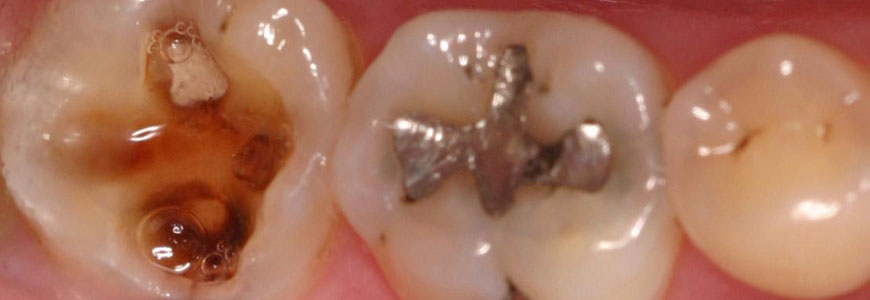
Dental cavities are caused by acid erosion of tooth enamel. Many different types of bacteria normally live in the human mouth. They accumulate on the surface of the teeth in a sticky film called plaque. Plaque forms easily in cracks, pits or fissures in the back teeth; between teeth; around dental fillings or bridgework; and near the gum line. Some of the plaque germs convert sugar and carbohydrates in the foods we eat into acids. These acids dissolve minerals in the surface of the tooth, forming microscopic pits or erosions that get larger over time.
Poor oral hygiene.
Manual toothbrushes and floss are not the only way to remove the plaque. In fact, automated brushes are one of the most effective ways to break up the plaque build-up on the teeth. Floss can be assisted by various oral irrigators. Styles and kinds of these devices are suggested by doctor based on the individual’s own need.
Poorly formed enamel and deep tooth crevices
This plaque seeks to find the most accessible areas to grow and destroy enamel
Poor diet and a diet high in carbohydrates
Food and drink high in carbohydrates break down quickly in to a highly sticky substance. Things like candy , Fruit juices and some carbonated beverages also promote plaque . And in diet soft drinks, read the label ; it has acid in the mix. This is not good for your teeth. Our dental hygienist can help you evaluate your diet to help you steer clear of the poor choices and make better ones.
Dry mouth conditions.
For patients, especially in their 60’s and older could be on multiple prescriptions that slow down or stop saliva flow. Saliva has naturally occurring components that inhibit plaque growth and adherence. Interrupting this process causes decay to appear even on front teeth and can destroy previous dental work.
Tooth grinding and bruxism.
Social and environmental stresses influence tooth grinding. Tooth grinding strips away the hard outer enamel layer leaving the softer dentin exposed.
A cavity caused by tooth decay is an infection. It is composed of harmful bacteria that combined with an acid environment, use sugar to attack the hard tissue of teeth (enamel and dentin). Given time this creates a little hole in a tooth, and if not repaired promptly with a filling, the cavity will simply continue to grow.
If a cavity is not treated it can destroy a good part of the tooth, making it hard to be restored with a conventional filling. If a lot of the tooth is gone, only a dental crown can fix it.
If the decay causing bacteria reaches the pulp chamber where the nerve and blood vessels are located, then the pulp becomes irritated and infected as well. This can eventually develop in to an abscess, which can be very painful. Only a root canal can fix a tooth when its pulp is infected, and a crown is then probably needed as a final restoration.
There are also situations where a tooth is so much destroyed by a cavity that nothing can be done to fix it, not even a root canal or a crown. Unfortunately in a case like this the tooth has to be extracted.
Treatment can help prevent tooth damages from developing into cavities.
Treatment may involve:
- • Fillings
- • Crowns
- • Root canals
Dentists fill teeth by removing the decayed tooth material with a drill and filling it with a material such as silver-alloy, gold, porcelain, or composite resin. Porcelain and composite resin more closely match the natural tooth appearance, and may be preferred for front teeth. Many dentists consider silver amalgam alloy and gold to be stronger, and these materials are often used on back teeth. There is a trend to use high strength composite resin in the back teeth as well.
Crowns or "caps" are used if tooth decay is extensive and there is limited tooth structure, which may cause weakened teeth. Large fillings and weak teeth increase the risk of the tooth breaking. The decayed or weakened area is removed and repaired. A crown is fitted over the remainder of the tooth. Crowns are often made of gold, porcelain, or porcelain attached to metal.
A root canal is recommended if the nerve in a tooth dies from decay or injury. The center of the tooth, including the nerve and blood vessel tissue (pulp), is removed along with decayed portions of the tooth. The roots are filled with a sealing material. The tooth is filled, and a crown is usually needed.

